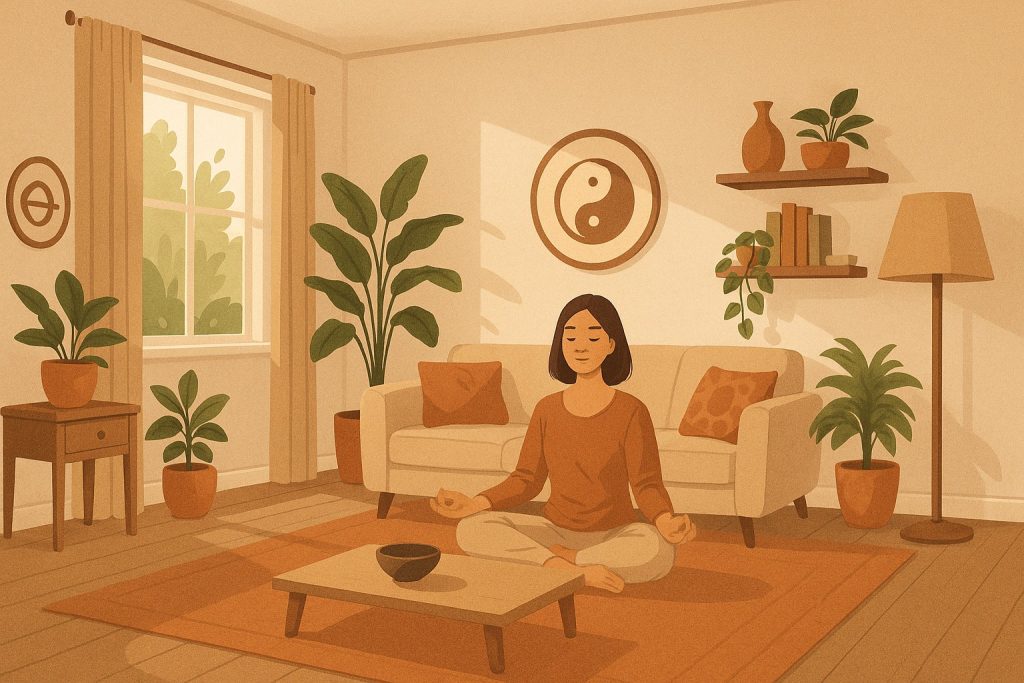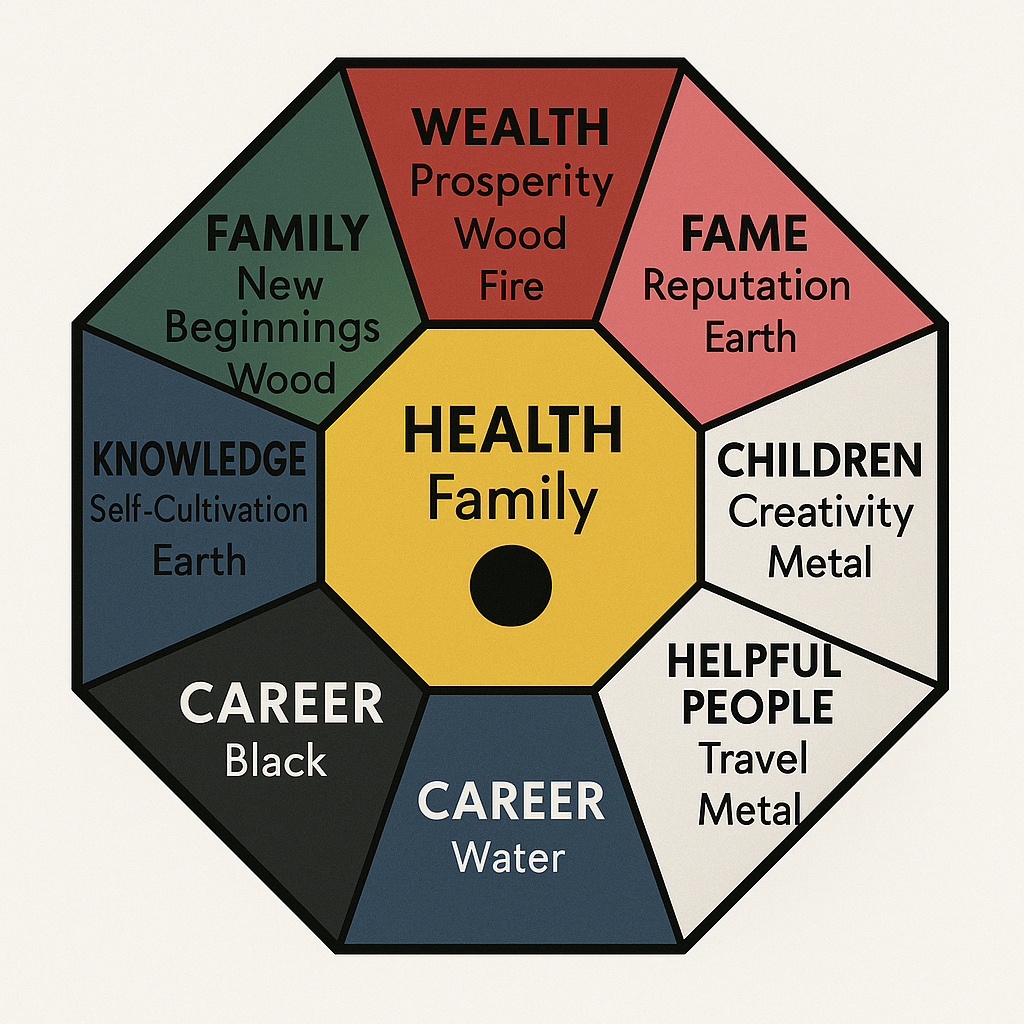By Paulo Cabral on June 3rd 2025

Have you ever felt uncomfortable even though you were inside your own home? Well, Feng Shui is an excellent way to control the negative energy that a place carries, even improving the well-being of all residents.
Feng Shui is an ancient Chinese practice rooted in the art, science, and wisdom of achieving harmony and balance among elements. It extends beyond mere aesthetics or creating a cozy space—it focuses on the flow of energy within a home, promoting both physical and mental well-being for its inhabitants.
Feng Shui, which translates to “wind” (feng) and “water” (shui) in Chinese, is based on the energy of these two elements. Its purpose is to create Taoist harmony—an essential concept in Chinese philosophy—by balancing energy between environments and individuals. Commonly applied in interior design, Feng Shui techniques aim to enhance the energy of a space, which in turn can positively influence personal relationships within the home. Closely connected to nature, this practice often incorporates elements such as natural stones, crystals, plants, and water fountains, making them highly recommended for both indoor and outdoor spaces.
Bagua
Bagua is a symbolic map applied to a home’s floor plan to identify and enhance harmony in each room. Each section, known as a gua, represents a different aspect of life, influencing energy flow within the space. These areas include career, spirituality, family, prosperity, success, relationships, creativity, friendships, and health.

The nine guas and their corresponding elements and colors are:
- Career – Element: Water; Color: Black/Dark Blue
- Spirituality and Wisdom – Element: Earth; Color: Light Blue/Beige
- Family – Element: Wood; Color: Green
- Prosperity – Element: Wood; Color: Purple
- Success and Recognition – Element: Fire; Color: Red
- Relationships – Element: Earth; Color: Pink
- Creativity and Children – Element: Metal; Color: White
- Friends and Travel – Element: Metal; Color: Gray
- Center/Health – Element: Earth; Color: Yellow
The Bagua areas are arranged in a structured pattern that can be applied to the floor plan of your home or even a single room. To use the Bagua effectively, start by obtaining or sketching your home’s floor plan, ensuring the rooms are as proportional as possible.
Elements of Feng Shui
The five elements of Feng Shui—fire, water, earth, metal, and wood—are fundamental to achieving balance and harmony. Known as phases of transformation, these elements originate from nature and are believed to influence specific areas of the human body in Chinese philosophy. When properly aligned, they help establish inner equilibrium and promote positive energy flow within a space.
- Wood represents growth and vitality. It is strengthened by water, which nourishes it, but can be weakened by fire and metal.
- Fire is dynamic and powerful, spreading in all directions. It requires wood to exist but can be extinguished by water. Since fire does not naturally occur without a source, it must be handled with care in Feng Shui.
- Metal is strong and rigid, often associated with prosperity through materials like silver and gold. It is inflexible in relation to other elements.
- Water is fluid yet powerful, capable of shaping landscapes and influencing energy flow. It symbolizes communication and success but can also lead to destruction if uncontrolled.
- Earth is the foundation of stability, representing gravity and nourishment. It supports growth but can be affected by both fire and wood—such as tree roots absorbing nutrients from the soil.
Applicability
Feng Shui in the living room emphasizes the use of chromotherapy, meaning that every color plays a significant role in shaping the energy of the space. Each hue carries a distinct influence, contributing to harmony, balance, and the overall ambiance of the room. Thoughtful color selection can enhance positivity, promote relaxation, and create a welcoming atmosphere that aligns with the desired energy flow in the home.
While light colors convey peace, darker and stronger colors are more social, stimulating creativity and dialogue. So, keep a balance!
When arranging furniture in the living room, the placement of the sofa is especially important. Ideally, it should be positioned against a wall rather than with its back facing the entrance, as this creates a sense of security and stability in the space. If this arrangement isn’t possible, consider placing additional furniture behind the sofa to support the flow of energy and maintain balance within the room.
Arranging the sofa in an “L” or “U” shape creates a welcoming atmosphere, giving the impression of warmth and connection while maintaining good energy circulation throughout the space.
Don’t overlook empty corners in the living room—leaving them unoccupied can lead to energy stagnation. To prevent this, consider placing a potted plant, a sculpture, or a small table to enhance the flow of positive energy.
For wall décor, choose vibrant and cheerful artwork, even abstract pieces, to promote a sense of optimism and high spirits. Incorporating images of cherished memories—such as family moments or travels—can serve as a source of encouragement, reinforcing focus and perseverance toward personal goals.
Another meaningful addition is the Feng Shui mirror, which symbolizes protection and is best placed above the front door. Considered a healing element, this mirror is often framed in gold, silver, or copper, materials associated with prosperity and positive energy.
Feng Shui in the Bedroom
The bed is the most important element in Feng Shui for the bedroom, and its placement significantly impacts energy flow. Ideally, it should be positioned away from the door, ensuring that your feet do not face it, as this arrangement is believed to help maintain vitality and promote restful sleep.
Additionally, avoid placing the bed directly against the wall, as this allows energy to circulate freely during sleep. A headboard is highly recommended, as it provides support and stability, helping you wake up feeling refreshed. Wooden headboards, in particular, serve as a protective barrier against external influences and the coldness of the wall.
Minimize work-related items and electronic devices in the bedroom, as they can interfere with relaxation. Even when powered off, these devices emit radiation that may impact physical and spiritual well-being. Keeping them out of the sleeping area helps create a peaceful, restorative environment.
Lighting also plays a crucial role in setting the mood of the space. Prioritize natural light during the day to refresh and energize the room. For artificial lighting, opt for warm, soft illumination to encourage relaxation and deeper sleep.
Feng Shui in the Bathroom
To maintain positive energy in the bathroom, always keep the door closed and the toilet lid down. Cleanliness and organization are essential, so store items like brushes and accessories in baskets or organizer boxes to prevent clutter. Avoid overcrowding the space with too many objects, as excess items can disrupt the flow of energy. Additionally, ensure that the bathroom door is not directly facing other rooms to prevent energy from being drained from those areas.
Feng Shui in the Kitchen
In the kitchen, the stove is the key element, much like the sofa in the living room. The person cooking should be able to see the door and should never have their back to it, as this positioning can create a sense of vulnerability. The stove should also not be aligned with the entrance; if repositioning is not an option, placing a multifaceted crystal between the door and the stove can help correct the energy imbalance.
And Finally…
Bringing Feng Shui into your home requires patience and commitment. Old habits may try to pull you back, making it easy to believe that “I am a disaster by nature.” Stay focused and embrace the fresh energies flowing into your space, allowing them to bring peace, balance, and harmony to your home.
